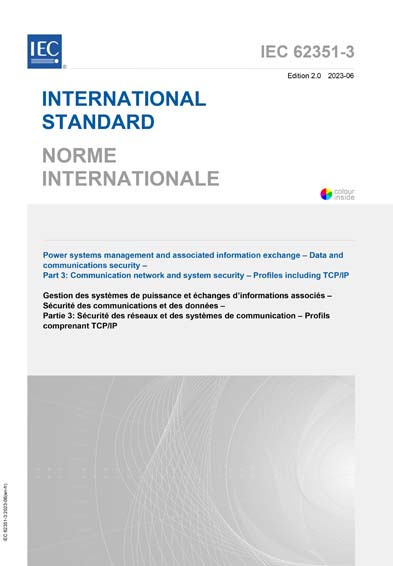Most recent
IEC 62351-3 Ed. 2.0 b:2023
Power systems management and associated information exchange - Data and communications security - Part 3: Communication network and system security - Profiles including TCP/IP
IEC 62351-3:2023 specifies how to provide confidentiality, integrity protection, and message level authentication for protocols that make use of TCP/IP as a message transport layer and utilize Transport Layer Security when cyber-security is required. This may relate to SCADA and telecontrol protocols, but also to additional protocols if they meet the requirements in this document.
IEC 62351-3 specifies how to secure TCP/IP-based protocols through constraints on the specification of the messages, procedures, and algorithms of Transport Layer Security (TLS) (TLSv1.2 defined in RFC 5246, TLSv1.3 defined in RFC 8446). In the specific clauses, there will be subclauses to note the differences and commonalities in the application depending on the target TLS version. The use and specification of intervening external security devices (e.g., "bump-in-the-wire") are considered out-of-scope.
In contrast to previous editions of this document, this edition is self-contained in terms of completely defining a profile of TLS. Hence, it can be applied directly, without the need to specify further TLS parameters, except the port number, over which the communication will be performed. Therefore, this part can be directly utilized from a referencing standard and can be combined with further security measures on other layers. Providing the profiling of TLS without the need for further specifying TLS parameters allows declaring conformity to the described functionality without the need to involve further IEC 62351 documents.
This document is intended to be referenced as a normative part of other IEC standards that have the need for providing security for their TCP/IP-based protocol exchanges under similar boundary conditions. However, it is up to the individual protocol security initiatives to decide if this document is to be referenced.
The document also defines security events for specific conditions, which support error handling, security audit trails, intrusion detection, and conformance testing. Any action of an organization in response to events to an error condition described in this document are beyond the scope of this document and are expected to be defined by the organization’s security policy.
This document reflects the security requirements of the IEC power systems management protocols. Should other standards bring forward new requirements, this document may need to be revised.
This second edition cancels and replaces the first edition published in 2014, Amendment 1:2018 and Amendment 2:2020. This edition constitutes a technical revision.
This edition includes the following significant technical changes with respect to the previous edition:
a) Inclusion of the TLSv1.2 related parameter required in IEC 62351-3 Ed.1.2 to be specified by the referencing standard. This comprises the following parameter:
• Mandatory TLSv1.2 cipher suites to be supported.
• Specification of session resumption parameters.
• Specification of session renegotiation parameters.
• Revocation handling using CRL and OCSP.
• Handling of security events.
b) Inclusion of a TLSv1.3 profile to be applicable for the power system domain in a similar way as for TLSv1.2 session.
Content Provider
International Electrotechnical Commission [iec]






